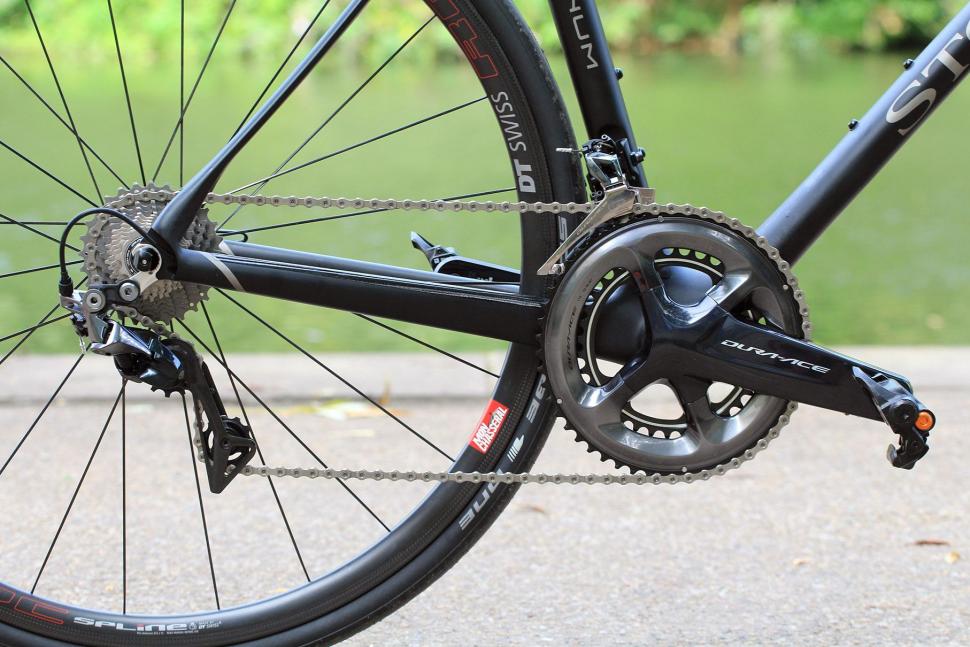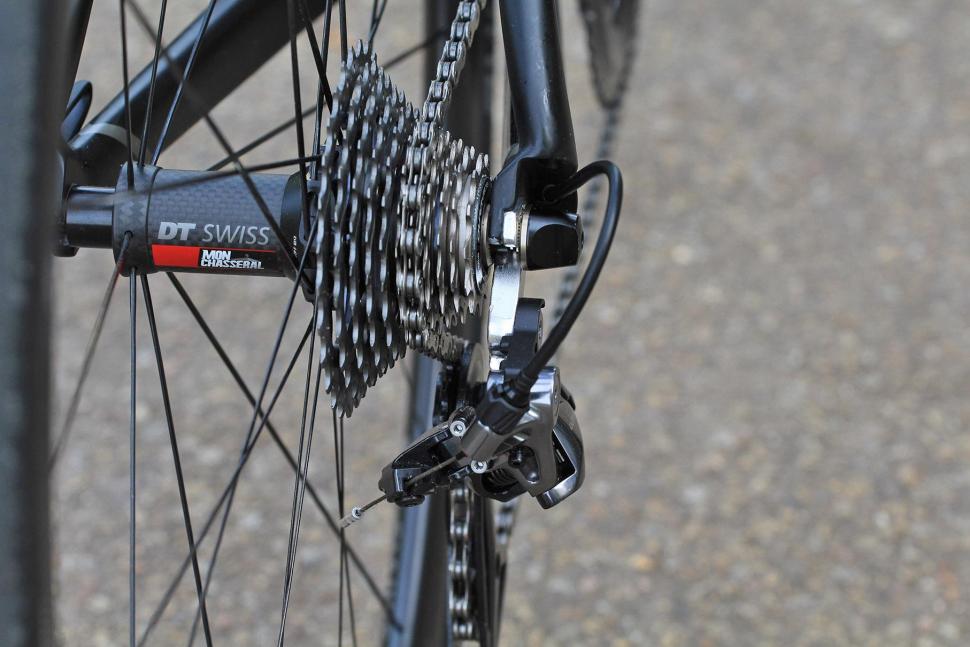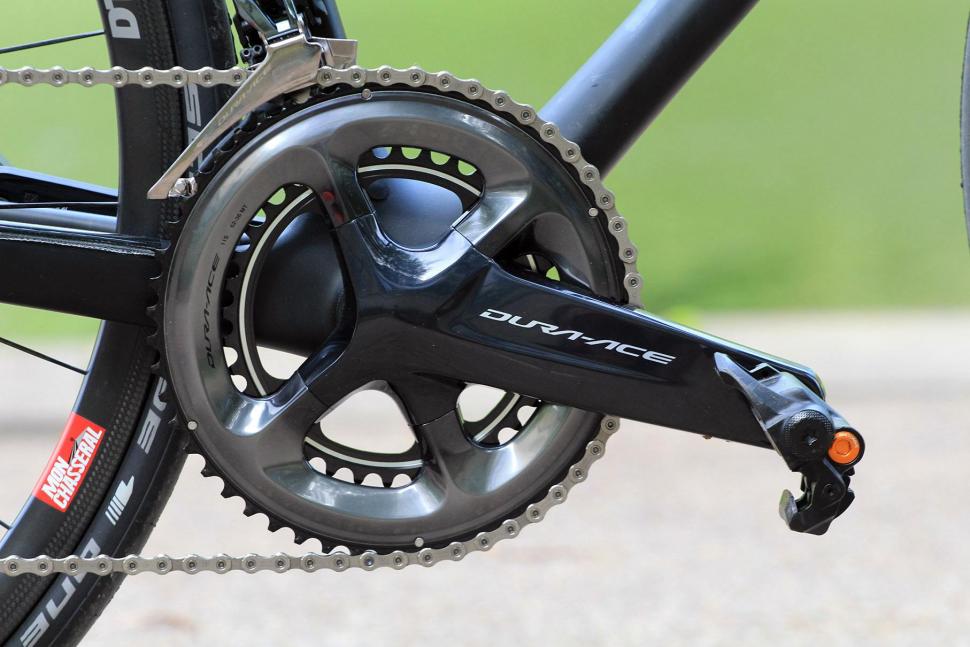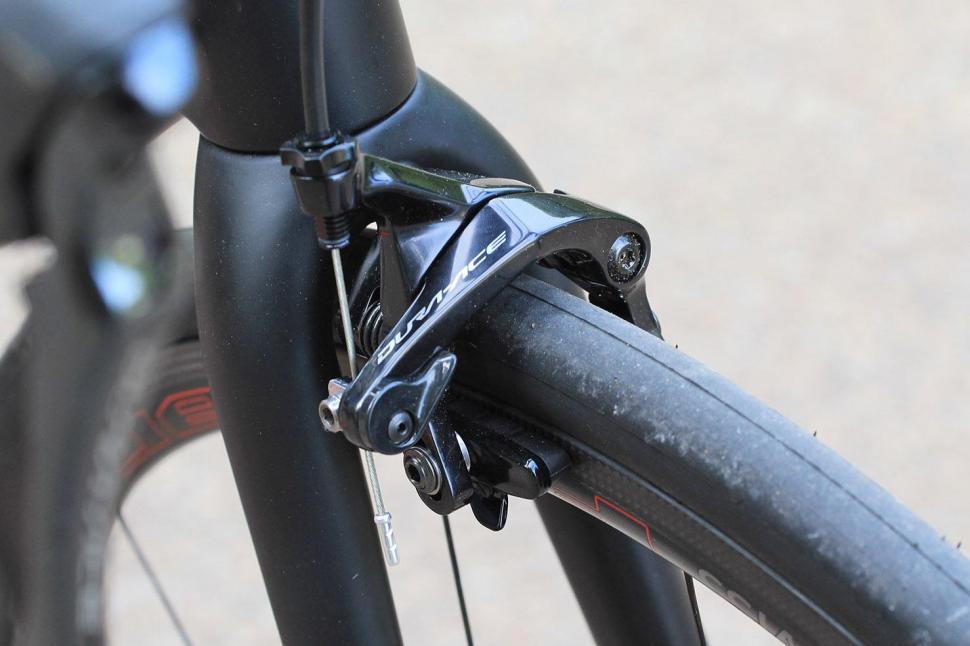- News
- Reviews
- Bikes
- Components
- Bar tape & grips
- Bottom brackets
- Brake & gear cables
- Brake & STI levers
- Brake pads & spares
- Brakes
- Cassettes & freewheels
- Chains
- Chainsets & chainrings
- Derailleurs - front
- Derailleurs - rear
- Forks
- Gear levers & shifters
- Groupsets
- Handlebars & extensions
- Headsets
- Hubs
- Inner tubes
- Pedals
- Quick releases & skewers
- Saddles
- Seatposts
- Stems
- Wheels
- Tyres
- Tubeless valves
- Accessories
- Accessories - misc
- Computer mounts
- Bags
- Bar ends
- Bike bags & cases
- Bottle cages
- Bottles
- Cameras
- Car racks
- Child seats
- Computers
- Glasses
- GPS units
- Helmets
- Lights - front
- Lights - rear
- Lights - sets
- Locks
- Mirrors
- Mudguards
- Racks
- Pumps & CO2 inflators
- Puncture kits
- Reflectives
- Smart watches
- Stands and racks
- Trailers
- Clothing
- Health, fitness and nutrition
- Tools and workshop
- Miscellaneous
- Buyers Guides
- Features
- Forum
- Recommends
- Podcast
TECH NEWS
Shimano Dura-Ace 9100 - First Ride Review
* Since this article was published, Shimano's Hollowtech 11-speed cranksets have been subject to an inspection and replacement programme in the United Kingdom, with similar actions taken in other territories worldwide. This is because "the outer cover of the crank arm may start to separate from the main crank arm body, posing potential fall and injury hazards to consumers".
You can read our article from 2023 for more details, and find the Product Safety Report from the UK's Office for Product Safety and Standards here. If you still have a Hollowtech product that is yet to be inspected or replaced, contact your local Shimano dealer.
One of the big product releases this year was Shimano’s new Dura-Ace 9100 groupset, unveiled to the world’s press in the days leading up to the Tour de France. Following that launch, it’s been rarely spotted save for a few showstopper bikes at Eurobike, but when the new Storck Durnario Platinium rolled into the office with the latest groupset fitted, I immediately set about racking up the miles. Here are my first ride impressions.
- Shimano reveals new top-end R9100 Dura-Ace groupset
A visual departure
The biggest and most immediately obvious change is the visual appearance, a new glossy black finish (to match your gloss black iPhone 7) and angular design replace the smooth lines and grey/silver finish of the current Dura-Ace 9000.
Functionally, the changes are less dramatic. It’s still an 11-speed groupset, but it’s lost some weight and gained some ergonomic and aerodynamic improvements. And, as I’ve found from riding it for the last few weeks, the update ensures Dura-Ace is still the benchmark mechanical groupset by which all others are judged.
- New Shimano Dura-Ace R9100: 5 key innovations
It’s not as big a leap forward as previous Dura-Ace groupset releases have been and instead, builds on the solid performance foundations of Dura-Ace 9000. If it’s not broke and all that… The first thing to note is that it feels very similar to Dura-Ace 9000, but look a bit closer and there are some useful changes that all combine to make it just a bit slicker and nicer to use. I’m talking very marginal improvements here, which is perhaps an indication that Shimano has probably pushed mechanical groupsets as far as it can.
- Review: Shimano Dura-Ace 9000 groupset
Here's how Shimano describes the new groupset:
"The DURA-ACE groupset is the result of Shimano’s ongoing passion for technology. This is reflected in every single component in the groupset. All components are joined together to work as one, reinforcing each other for unparalleled performance. This is how DURA-ACE achieves ultimate supremacy."
Revised hoods and shorter lever throw
The most tangible changes are the revised hoods. They now feel a bit more compact and are now wrapped in a new textured material that vastly improves the feel of the hoods and provides more grip when your hands are damp from the rain or sweat – especially if, like me, you prefer to ride without gloves. It makes holding the hoods a nicer experience compared with the smooth finish of the previous hood design.
Shimano has also reduced the lever throw, and you really do notice this, even though the change is small compared with the previous Dura-Ace. It’s not in the same ballpark as SRAM’s Red groupset, but still, it’s a nice improvement. Reach adjustment has also been increased, providing a bit more customisation than before. The paddle shifters inside of the brake lever are a touch larger and covered in a soft material that makes shifting gear easier. You notice this most when riding in the drops and combined with the increased range of reach adjustment, you can really dial in the levers to your preference.
Front and rear mech get all new look
Shimano says the shift action is lighter, but that is pretty tricky to detect, mainly because the previous groupset was so damn good. Really search for it, though, and there’s a slight improvement in the front shifting, it feels just a touch easier and lighter, whether shifting up or down and seems to work better under load. Yes I know, shifting gear while on the gas isn't optimum shifting technique, but I have to test these things, and sometimes you just need to change gear fast, such as in a race. Rear shifting feels about the same, though the shorter lever throw does produce slightly snappier changes.
The long arm of the front derailleur has gone and has been replaced with a much more compact design using a cam mechanism. This change was brought about by the increasing popularity for wide tyres. Shimano has repackaged the front mech to provide more clearance so bike manufacturers can squeeze bigger tyres into frames without the front mech causing problems. Cable routing is a bit cleaner and you can now run a full outer housing to the front mech, and there’s a cable tension adjust Allen bolt.
Somehow, Shimano has not only managed to retain the light shift action of the previous Dura-Ace 9000, but it's managed to find a small improvement. Another change that certainly seems to help is the redesigned internal shifting mechanism in the front shifter. It certainly appears to work. It takes very little force to change gear, with one-finger shifting a doddle, and the shorter lever throw provides a noticeable improvement in shift time and speed. Downshifts feel a smidgen quicker than previous Dura-Ace 9000, but the overriding impression is that none of the stellar performance has been lost.
The rear derailleur has had a radical redesign. It looks like something from a sci-fi movie now. It has come about because Shimano has brought the Shadow technology, with its direct mount design, over from the mountain bike category to the road market for the first time. The result is a lower profile mechanism – look at it from the side and it juts out from the frame much less than the original. That provides better crash protection and, you could say, aerodynamics, but these were two aspects I wasn't able to test during my time with it.
The change hasn't caused a negative impact on the shifting quality. Performance is every bit as good as before, and with the shorter lever throw, gear changes are a shade quicker. You really have to search for the improvements, but the important thing is that it's still quick, precise, crisp, quiet and all the words that are usually summoned up to describe Shimano groupsets.
Another critical change, in much the same way that the front mech has been redesigned in response to wider tyres, is that the rear mech has been revised to accommodate the trend for wide-range cassettes. It’ll work with an 11-30t cassette, but it wouldn’t surprise us if it goes higher than that.
Chainset changes
The new completely revamped chainset divided opinion when it launched, but spend time with it as I have and it does grow on you – just like every previous Dura-Ace groupset has done. Looks aside, the new chainset has the same Hollowtech II construction but with wider arms and a more reinforced outer chainring, which has allowed Shimano to reduce the weight but keep the stiffness of the previous generation chainset. That’s an improvement you’ll see on the scales but is impossible to detect from the pedals. It’ll be available in 50-34T, 52-36T, 53-39T, 54-42T and 55-42T with crank lengths ranging from 165mm to 180mm.
The brake callipers have been tweaked and now provide clearance for up to 28mm tyres. The new quick release lever sits flush with the top arm of the brake calliper when in the closed position, providing a smarter appearance. Braking performance has always been impressive with Dura-Ace rim brake callipers, and that holds true with the updated callipers. There will doubtless be a disc brake version along soon enough, and direct mount brakes will be available.
Conclusion
It’s perhaps easy to be underwhelmed by the performance of the new Dura-Ace 9100 groupset on the first ride, but that’s only because Shimano set such a high benchmark with Dura-Ace 9000. The list of changes, though small, do add up to a tangible improvement. It’s still a wonderful groupset to use and if you’re not a fan of electronic groupsets, Dura-Ace 9100 is a good alternative. Better than that, I personally prefer the ergonomics of the mechanical version, savouring the sweet action of moving a lever rather than pushing a button. But that’s just me.
The evolution rather than revolution approach of Dura-Ace 9100 is probably testament to the fact that Shimano has likely reached the end of the development path for a mechanical groupset. Can it really get better than this? Given the race-focused development of Dura-Ace, and with the majority of the pro peloton on Di2 these days, will Shimano feel the need to continue to search for improvements in its mechanical groupsets? Away from pro racing, there’s still a place for mechanical in bike ranges where price is a factor, but will that be enough to drive Shimano to continue to develop it in the same way it has over the past 10 years? Time will tell.
So, to wrap up, Dura-Ace 9100 provides exceedingly good performance with super-light shifting and the best ergonomics of any groupset, backed up by the solid dependability Dura-Ace is founded upon, and now wrapped up in a very modern outfit.
More info at www.duraace.com and thanks to Storck for lending us a bike fitted with the new groupset.
David worked on the road.cc tech team from 2012-2020. Previously he was editor of Bikemagic.com and before that staff writer at RCUK. He's a seasoned cyclist of all disciplines, from road to mountain biking, touring to cyclo-cross, he only wishes he had time to ride them all. He's mildly competitive, though he'll never admit it, and is a frequent road racer but is too lazy to do really well. He currently resides in the Cotswolds, and you can now find him over on his own YouTube channel David Arthur - Just Ride Bikes.
Latest Comments
- Backladder 1 sec ago
Frequent 502 and 404 errors this morning so its not looking good at the moment.
- chrisonabike 9 hours 38 min ago
Nothing to do with cycling or transport but a "decent man" making a principled stand. Not just a sleazy type irked that he was snubbed, and jumping...
- chrisonabike 9 hours 50 min ago
True. But a with so many things it's probably the thousands / millions of much smaller contributions from the rest of us which really tip the...
- WhichWayNow 10 hours 24 min ago
I had some rim brake CLX50 in 2017 that had 21mm internal width. Very few wheels are coming with a 21mm internal width these days. That's why I...
- Another_MAMIL 11 hours 26 min ago
Is this Rapha jacket for poor people? No respectable cyclist would pay anything less than £410 for a jacket......
- kingleo 12 hours 26 min ago
Trying to distract attention away from the road users who do most of the killing and injuring: car drivers.
- LeadenSkies 13 hours 19 min ago
Wogan Junior's comments show the dangers of leaving far too much money to your kids. The bloke thinks he is somehow a celebrity. He wishes. Don't...
- j4m1eb 13 hours 36 min ago
I was amazed that it was included in my membership and to top it off somehow I manged to pay via my iphone and therefore paid £3.99!
- Slartibartfast 13 hours 47 min ago
"For the first time ever – probably because it was cold – Parthena-Rose was wearing her helmet and body protection in the car, which may have saved...



































Add new comment
26 comments
Shorter lever throw? Check!
Rear mech with an offset in the parallelogram? Check!
Crank arm that has an offset bridge to the spider? Check!
Textured hoods? Check!
They've been copying Campagnolo's 2015 groups.
SP59. You said the group was a crock not that it being sold as an improvement was, learn to write. As for looks, I don't really care, can't say I've ever liked Dura Ace, hate that silver and black in particular but that's got sod all to do with how it performs. Which everyone that's tried it and reported had said is excellent. In particular all have mentioned they felt there were *some* improvements, albeit slight, to the existing Dura Ace groupset - which it was being billed as. you may think they should have done more, fair enough, again doesn't alter how it actually, in the real world, performs not whether it is an improvement. They've tried it, as far as I know you haven't, so your opinion really isn't worth anything far as how it rides is it ? So that leaves a couple of minor technical points, e.g. mech capacity, which in more than happy to debate with you but are still fairly irrelevant overall.
I'm not buying into anything, and even I was that wouldn't make this a shit groupset, you need to get a grip, gets more like listening to a Trump speech every day.
I find it somewhat amazing that the, cheapest, lightest, most efficient, way of transferring power from pedal to rear wheel involves chains and cogs.
You can definitely blow the current setup out of the water on those terms - but user access and serviceability would be the challenge. Then there's the UCI who really are killing innovation for the whole market with their rules. We'd be a decade ahead if it wasn't for the UCI.
The P1's add that final touch of class!
@BikeJon - not sure what you're getting at. Yes, this is a performance groupset but it's not a 1x.
If you are wearing out a chain quicker, then you have introduced more friction, which means there is wattage expenditure to be had. Apparently this can be in the region of 5W at serious race speeds. Granted, this isn't much of a factor for many of us but we're talking about a performance groupset here.
Maybe some other clever tech will be developed that 'shifts' the single front ring somehow to help maintain a decent chain line as you shift across the cassette at the back?
There's a 1.85mm difference between Shimano 10 and 11 speed hubs. Not a whole lot less crossing to enjoy.
While getting rid of the front mech seems a great idea as far as simplicity and ease of maintenance are concerned, I am not very fond of a chain that crosses and drags you behind. Otherwise a 11-cogged 11-36 cassette would be great for my urban needs.
In theory it sounds problematic, in practice it's all pretty good. Worst case you change the chain a bit more often.
But 11 speed is an expensive business still. 10 speed is perfect. Less crossing, sub £20 cassettes. Tidy.
"the best ergonomics of any groupset", you say...
That chainset looks sweet with the black and grey.
Bugger, I have a gold Galaxy S7 Edge. I'm out.
I wonder how much better it would have worked if the chain had been the right length? Judging by the pix, it's at least four links short.
What the F@@K have shimano engineers been thinking? the whole system looks so cheap!!! what is this!!
I think the groupset has a gradient to the colour, that doesn't show in photographs easily. Hope so anyway or else it just looks like 105 that ate too much.
See here:
Yep. The brushed metal facing of the previous DA sets it apart from the lower gruppos. This looks like it could be any other lower Shimano set up, 105, Tiagra...it's mehblah
Theoretically, how many gears at the back would you need before getting rid of a second ring at the front, and still have a complete range for mountain climbing and flatter road racing.
9-36 with 52 at the front. Something like that, maybe 13 cogs on the cassette?
Just wondering where we might be headed some day. Groupset looks nice, though uninspiring. I wonder if the new Di2 version is much of an upgrade over 9070, or is all the magic going to be in the power meter crank..
Anyway, for the money. I'd take current gen Di2 Ultegra. Missus has it and it's so much nicer than my DA 9000 mechanical.
it is not about range, more about fine increments.
I would hate riding a cassette with 2teeth jumps even at the bottom. for me, 14-15-16-17-18-19 are essential for my flat rides. I cannot afford to loose fine steps on my rear cluster.
ideally I'd ride something like 50-36 with 13-29 eleven speed at the rear
I agree with this.
My prediction is that once we reach the natural conclusion of the race for more cassette rings (14/15 speed, whatever) and have achieved as much range as any cyclist would ever need even with reasonable shift jumps, then the next big thing will be a re-imagining of what a "tooth" size is.
I think that the chainring and cassette teeth will be scaled down except for maybe retaining their height, allowing for there to be more teeth on the average chainrings and cassette rings. Imagine a 100/68 chainset rather than a 50/34 for example.
The advantage of this would be the ability to have finer incremental adjustments at the rear through single step differences equivalent to only half a tooth step on a current cassette, and better tailored chainsets (although I'd argue that this part doesn't really matter much given the options out there currently)
The chains would wear out faster through being smaller/thinner, and people who wanted longetivity would complain, but I think that performance cyclists would go for it.
I saw something in print recently that said that Shimano actually has a patent for a 14 speed set up.
Not that April Fool's joke is it?
http://factoryjackson.com/2016/04/01/shimano-14-speed-xt-samurai-unveiled/
The patent was used to make the joke convincing, but seems to really exist:
http://www.google.co.uk/patents/US5954604
Sheesh, don't age me. I started racing in 1986 and it was the first year that 6 sp reached us in NZ. I'm pretty sure 5 sp clusters were common well into the 80's across all racing ranks.
For road bikes, the answer is never, at least not for competitive road racing... got to have two chainrings for making a substantially large gear-ratio change with one click. Needing three or four clicks in the heat of the moment is two or three clicks too many.